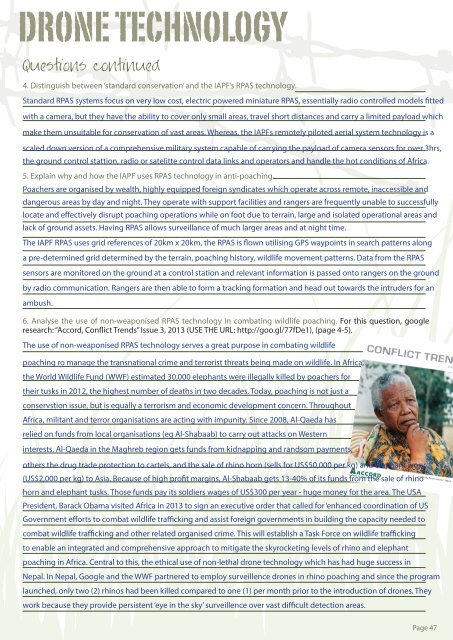You also want an ePaper? Increase the reach of your titles
YUMPU automatically turns print PDFs into web optimized ePapers that Google loves.
DRONE TECHNOLOGY<br />
Questions continued<br />
4. Distinguish between ‘standard conservation’ and the IAPF’s RPAS technology.<br />
Standard RPAS systems focus on very low cost, electric powered miniature RPAS, essentially radio controlled models fitted<br />
with a camera, but they have the ability to cover only small areas, travel short distances and carry a limited payload which<br />
make them unsuitable for conservation of vast areas. Whereas, the IAPFs remotely piloted aerial system technology is a<br />
scaled down version of a comprehensive military system capable of carrying the payload of camera sensors for over 3hrs,<br />
the ground control stattion, radio or satelitte control data links and operators and handle the hot conditions of Africa.<br />
5. Explain why and how the IAPF uses RPAS technology in anti-poaching.<br />
Poachers are organised by wealth, highly equipped foreign syndicates which operate across remote, inaccessible and<br />
dangerous areas by day and night. They operate with support facilities and rangers are frequently unable to successfully<br />
locate and effectively disrupt poaching operations while on foot due to terrain, large and isolated operational areas and<br />
lack of ground assets. Having RPAS allows surveillance of much larger areas and at night time.<br />
The IAPF RPAS uses grid references of 20km x 20km, the RPAS is flown utilising GPS waypoints in search patterns along<br />
a pre-determined grid determined by the terrain, poaching history, wildlife movement patterns. Data from the RPAS<br />
sensors are monitored on the ground at a control station and relevant information is passed onto rangers on the ground<br />
by radio communication. Rangers are then able to form a tracking formation and head out towards the intruders for an<br />
ambush.<br />
6. Analyse the use of non-weaponised RPAS technology in combating wildlife poaching. For this question, google<br />
research: “Accord, Conflict Trends” Issue 3, 2013 (USE THE URL: http://goo.gl/77fDe1), (page 4-5).<br />
The use of non-weaponised RPAS technology serves a great purpose in combating wildlife<br />
poaching ro manage the transnational crime and terrorist threats being made on wildlife. In Africa,<br />
the World Wildlife Fund (WWF) estimated 30,000 elephants were illegally killed by poachers for<br />
their tusks in 2012, the highest number of deaths in two decades. Today, poaching is not just a<br />
conservstion issue, but is equally a terrorism and economic development concern. Throughout<br />
Africa, militant and terror organisations are acting with impunity. Since 2008, Al-Qaeda has<br />
relied on funds from local organisations (eg Al-Shabaab) to carry out attacks on Western<br />
interests. Al-Qaeda in the Maghreb region gets funds from kidnapping and randsom payments,<br />
others the drug trade protection to cartels, and the sale of rhino horn (sells for US$50,000 per kg) and elephant ivory<br />
(US$2,000 per kg) to Asia. Because of high profit margins, Al-Shabaab gets 13-40% of its funds from the sale of rhino<br />
horn and elephant tusks. Those funds pay its soldiers wages of US$300 per year - huge money for the area. The USA<br />
President, Barack Obama visited Africa in 2013 to sign an executive order that called for ‘enhanced coordination of US<br />
Government efforts to combat wildlife trafficking and assist foreign governments in building the capacity needed to<br />
combat wildlife trafficking and other related organised crime. This will establish a Task Force on wildlife trafficking<br />
to enable an integrated and comprehensive approach to mitigate the skyrocketing levels of rhino and elephant<br />
poaching in Africa. Central to this, the ethical use of non-lethal drone technology which has had huge success in<br />
Nepal. In Nepal, Google and the WWF partnered to employ surveillence drones in rhino poaching and since the program<br />
launched, only two (2) rhinos had been killed compared to one (1) per month prior to the introduction of drones. They<br />
work because they provide persistent ‘eye in the sky’ surveillence over vast difficult detection areas.<br />
Page 47



